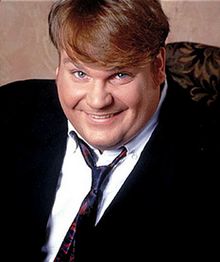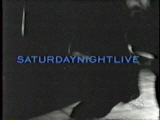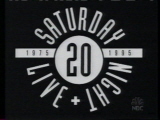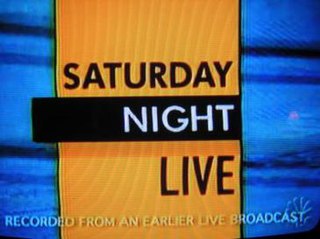Related Research Articles

Christopher Crosby Farley was an American comedian and actor. He was known for his loud, energetic comedic style, and was a member of Chicago's Second City Theatre and later a cast member of the NBC sketch comedy show Saturday Night Live for five seasons from 1990 to 1995. He went on to pursue a film career, appearing in films such as Airheads, Tommy Boy, Black Sheep, Beverly Hills Ninja, and Almost Heroes.

Pat O'Neill Riley is an androgynous fictional character created and performed by Julia Sweeney for the American sketch comedy show Saturday Night Live (SNL) from 1990 to 1994. The character was later featured in the film It's Pat. The central humorous aspect of sketches featuring Pat is the inability of others to determine the character's sex.
Saturday Night Live is an American sketch comedy series created by Lorne Michaels, who also produced many episodes. The show has aired on NBC since 1975.
Saturday Night Live is an American sketch comedy series created and produced by Lorne Michaels for most of the show's run. The show has aired on NBC since 1975.
The following is a list of recurring Saturday Night Live sketches, organized alphabetically by title. The referenced date is the date when the sketch first appeared.
Saturday Night Live has long mocked the television medium with many fake commercials and parodies of TV shows themselves. Another of the show's frequently used styles of recurring sketches has been the talk show format. However, anything from cop shows to children's shows has been fair game for the ever-changing cast.

The twenty-second season of Saturday Night Live, an American sketch comedy series, originally aired in the United States on NBC between September 28, 1996, and May 17, 1997.

The twentieth season of Saturday Night Live, an American sketch comedy series, originally aired in the United States on NBC between September 24, 1994, and May 13, 1995.

The nineteenth season of Saturday Night Live, an American sketch comedy series, originally aired in the United States on NBC between September 25, 1993, and May 14, 1994.

The eighteenth season of Saturday Night Live, an American sketch comedy series, originally aired in the United States on NBC between September 26, 1992, and May 15, 1993.
The seventeenth season of Saturday Night Live, an American sketch comedy series, originally aired in the United States on NBC between September 28, 1991, and May 16, 1992.

The sixteenth season of Saturday Night Live, an American sketch comedy series, originally aired in the United States on NBC between September 29, 1990, and May 18, 1991.

The twelfth season of Saturday Night Live, an American sketch comedy series, originally aired in the United States on NBC between October 11, 1986 and May 23, 1987.

David Wayne Spade is an American comedian and actor. After several years as a stand-up comedian, Spade rose to prominence as a writer and cast member on the NBC sketch comedy series Saturday Night Live from 1990 to 1996. Following his departure from SNL, he began an acting career in both film and television, starring or co-starring in the films Tommy Boy (1995), Black Sheep (1996), Senseless (1998), Joe Dirt (2001), Dickie Roberts: Former Child Star (2003), The Benchwarmers (2006), Grown Ups (2010) and its 2013 sequel, The Ridiculous 6 (2015), The Do-Over (2016), and The Wrong Missy (2020).
The following is a list of recurring Saturday Night Live (SNL) characters and sketches introduced between September 28, 1991, and May 16, 1992, the seventeenth season of SNL.
The following is a list of recurring Saturday Night Live characters and sketches introduced between September 26, 1992, and May 15, 1993, the eighteenth season of SNL.

"Saturday Night Live 40th Anniversary Special" is a three-and-a-half-hour prime-time special that aired on February 15, 2015, on NBC, celebrating Saturday Night Live's 40th year on the air, having premiered on October 11, 1975, under the original title NBC's Saturday Night. It is produced by Broadway Video. This special generated 23.1 million viewers, becoming NBC's most-watched prime-time, non-sports, entertainment telecast since the Friends series finale in 2004. It is the third such anniversary special to be broadcast, with celebratory episodes also held during the 15th and 25th seasons.
The 42nd President of the United States, Bill Clinton, has been parodied on Saturday Night Live (SNL) since 1992. Clinton was in office from 1993 to 2001, and has been portrayed on the show over a hundred times, most often by Darrell Hammond.
References
- ↑ "Saturday Night Live (SNL) | History, Cast Members, & Facts | Britannica". www.britannica.com. January 11, 2024. Retrieved January 14, 2024.
- ↑ "Saturday Night Live (1975-) ratings". Rating Graph. Retrieved January 14, 2024.
- ↑ Evans, Bradford (September 27, 2013). "The 8 Biggest Transitional Seasons in 'SNL' History". Vulture . Retrieved May 8, 2024.
- ↑ Shales & Miller 2002, pp. 338–339.
- 1 2 3 4 5 Saturday Night Live in the '90s: Pop Culture Nation. NBC. May 6, 2007. Retrieved May 8, 2024.
- ↑ Adalian, Josef (June 2, 2017). "How Each Era of SNL Has Ridiculed American Presidents". Vulture . Retrieved April 30, 2024.
- 1 2 3 4 Siegel, Alan (September 11, 2019). "Comedy in the '90s, Part 3: The Bad Boys of 'Saturday Night Live'". The Ringer . Retrieved April 30, 2024.
- ↑ "SNL - Bad Boys Of Saturday Night Live". Amazon. Retrieved April 30, 2024.
- ↑ Fallon, Kevin (June 14, 2015). "The Secrets of 'Saturday Night Live': Where Comedy Legends Are Born". The Daily Beast . Archived from the original on June 5, 2017. Retrieved May 8, 2024.
- ↑ Hoglund, Andy (December 13, 2018). "Ellen Cleghorne on Breaking Down Saturday Night Live's Racial Barriers, and the Ones That Remain". Slate . ISSN 1091-2339 . Retrieved May 8, 2024.
- 1 2 Kahn, Eve (February 22, 1992). "Women getting to do more on 'SNL'". The Dispatch. New York Times News Service. p. 18. Retrieved May 8, 2024.
- ↑ Hoglund, Andy (September 24, 2020). "Siobhan Fallon Hogan Gave Michael Jordan Some Helpful Advice on SNL". Vulture . Retrieved May 8, 2024.
- ↑ Shales & Miller 2002, pp. 369–372.
- ↑ Rose, Charlie (February 8, 1996). "Tim Robbins Interview". PBS. Archived from the original on February 15, 2011. Retrieved May 9, 2010.
- ↑ Weintraub, Joanne (July 30, 1994). "Julia Sweeney leaves; has future down Pat". Milwaukee Journal . p. B8. Retrieved April 30, 2024– via The Vindicator.
- ↑ "So Long, Farewell". SNL Transcripts. Retrieved April 30, 2024.
- ↑ "SNL cast the next gig for Michael McKean". Ocala Star-Banner. March 11, 1994. p. 2A. Retrieved May 8, 2024.
- 1 2 Gay, Verne (September 23, 1994). "'Saturday Night Live' hoping new changes will give show new life". Newsday. p. D6. Retrieved April 30, 2024– via The Daily Gazette.
- ↑ Moore, Frazier (September 25, 1995). "'Saturday Night Live': It's back…and then?". The Associated Press. p. D4. Retrieved April 29, 2024– via The Free Lance-Star.
- 1 2 Shales & Miller 2002, pp. 416–418.
- ↑ Smith, Chris (March 13, 1995). "How 'Saturday Night Live' Became a Grim Joke". New York Magazine . Retrieved April 30, 2024.
- 1 2 Stern, Marlow (September 12, 2014). "Adam Sandler Talks Getting Fired From 'SNL,' Bad Reviews, and His Desire to Play A Villain". The Daily Beast . Archived from the original on October 3, 2023. Retrieved May 8, 2024.
- ↑ Mohr, Jay (2004). Gasping for Airtime: Two Years in the Trenches of Saturday Night Live. Hatchette Books. pp. 284–288. ISBN 978-1401399818.
- ↑ Wright, Megh (July 29, 2014). "Saturday Night's Children: Morwenna Banks (1995)". Vulture. Retrieved April 30, 2024.
- ↑ Hall, Jane (July 4, 1995). "NBC Looks to Restore the Shine on 'SNL'". Los Angeles Times . Archived from the original on August 3, 2022. Retrieved April 30, 2024.
- ↑ Evans, Bradford (September 27, 2013). "The 8 Biggest Transitional Seasons in 'SNL' History". Vulture. Retrieved April 30, 2024.